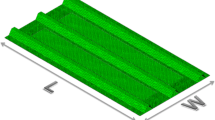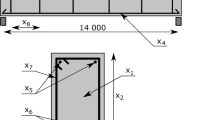Abstract
This paper proposes a constraint satisfaction problem algorithm based on implicit decision trees and dynamic programming for the design of multiple composite panels subjected to a set of blending rules and external forces. This decision tree is built incrementally on the ‘fly’, adding plies from a particular set, and does not require any guiding laminate or stacking sequence table for blending purposes. The upper bound algorithm complexity is provided in this work. The technique is applied to the design of a well-known composite multi-panel problem addressed in previous studies; the novel procedure exhibits high-quality solutions (in terms of structure weight) and low computational cost (in terms of laminate evaluations). The novel algorithm scalability is also checked showing that the node tree expansion is independent of the number of panels to be designed. This algorithm could therefore be a suitable choice for large-scale multi-panel design problems.














Similar content being viewed by others
Abbreviations
- BB:
-
Building block
- BFS:
-
Breadth-first search
- λ:
-
Lambda Buckling scaling load
- CFRP:
-
Carbon fiber reinforced plastic
- CLT:
-
Classical laminate theory
- FSD:
-
Fully stressed design
- FEM:
-
Finite element method
- GA:
-
Genetic algorithm
- RHS:
-
Right-hand side
- P:
-
Polynomial complexity
- NP:
-
Non-polynomial complexity
- SST:
-
Stacking sequence table
References
Adams DB, Watson LT, Gürdal Z, Anderson-Cook CM (2004) Genetic algorithm optimization and blending of composite laminates by locally reducing laminate thickness. Adv Eng Softw 35–43
Bailie JA, Ley RP, Pasricha A (1997) A summary and review of composite laminate design guidelines. NASA Contract:NAS1–NAS19347
Barroso ES, Parente E, Cartaxo de Melo AM (2017) A hybrid PSO-GA algorithm for optimization of laminated composites. Struct Multidiscip Optim 55:2111. https://doi.org/10.1007/s00158-016-1631-y
Bishop CM (2006) Patten recognition and machine learning. Springer. ISBN-10:0-387-31073-8
Eckold G (1994) Design and manufacture of composite structures. Woodhead Publishing
Fan H-T, Wang H, Chen X-H (2016) An optimization method for composite structures with ply-drops. Compos Struct 136(2016):650–661
Goldberg DE (1989) Genetic algorithms in search, optimization and machine learning. Addison Wesley Longman. Inc. ISBN 0-201-15767-5
Guttag JV (2013) Introduction to computation and programming using Python. MIT Press
Irisarri F-X, Abdalla MM, Gürdal Z (2011) Improved Shephard’s method for the optimization of composite structures. AIAA J 49(12):2726–2736
Irisarri F-X, Lasseigne A, Leroy F-H, Le Riche R (2014) Optimal design of laminated composite structures with ply drops using stacking sequence tables. Compos Struct 107:559–569
Jing Z, Sun Q, Silbershmidt VV (2016) Sequential permutation table method for optimization of stacking sequence in composite laminates. Compos Struct. https://doi.org/10.1016/j.compstruct.2016.01.052
Jones RM (1999) Mechanics of composite materials. Taylor & Francis (materials Science & Engineering Series)
Karakaya Ş, Soykasap (2011) Natural frequency and buckling optimization of laminated hybrid composite plates using genetic algorithm and simulated annealing. Struct Multidiscip Optim 43:61. https://doi.org/10.1007/s00158-010-0538-2
Kollár LP, Springer GS (2003) Mechanics of composite structures. Cambridge University Press. ISBN 978-0-521-80165-2
Liu D, Toporov, VV, Zhou M Barton D (2010) Optimization of blended smeared stiffness technique and lamination parameters. https://doi.org/10.2514/6.2010-3079. Conference: 51st AIAA/ASME/ASCE/AHS/ASC structures, structural dynamics, and materials conference 18th AIAA/ASME/AHS adaptive structures conference 12th
Manan A, Vio GA, Harmin MY (2010) Optimization of aerolastic composite structures using evolutionary algorithms. Eng Optim 42(2):171–181
Rossi F, van Beek P, Walsh T (2006) Handbook of constraint programming. Elsevier, p 157. ISBN 978-0-444-52726-4
Rusell SJ, Norvig P (2016) Artificial intelligence: a modern approach. Pearson. ISBN10:1292153962
Sanz-Corretge J (2017) A procedure to design optimum composite plates using implicit decision trees. Struct Multidiscip Optim. https://doi.org/10.1007/S00158-017-1711-7
Sanz-Corretge J (2018) An A-STAR algorithm for thick composite laminate design. AAOAJ 2(3)
Sanz-Corretge J, Echeverría M (2017) A novel technique for the design of hybrid composite laminates based on dynamic programming and dynamic tree trimming. Struct Multidiscip Optim 1–15. https://doi.org/10.1007/s00158-017-1822-1
Serestra O, Abdalla MM, Gürdal Z (2009) ‘A genetic algorithm based blending scheme for design of multiple composite laminates’. 50 th AIAA/ASME/ASC structures, structural dynamics and materials conference. 4–7 may. Palm Springs, California, p 2009
Soremekun G, Gürdal Z, Kasssapoglou C, Toni D (2002) Stacking sequence blending of multiple composite laminates using genetic algorithms. Compos Struct 56:53–62
Vanderplaats GN (1999) Numerical optimization techniques for engineering desgin. ISBN 0-944956-00-9
Yang J, Song B, Zhong X, Jim P (2016) Optimal design of blended composite laminate structures using ply drop sequence. Compos Struct 135(2016):30–37
Zein S, Colson B, Grihon S (2011) A primal-dual backtracking optimization method for blended composite structures. Struct Multidiscip Optim 45:669–680. https://doi.org/10.1007/s00158-011-0716-x
Zein S, Basso P, Grihon S (2014) A constraint satisfaction programming approach for computing manufacturable stacking sequences. Comput Struct 136:56–63. https://doi.org/10.1016/j.compstruc.2014.01.016
Zein S, Madhavan V, Dumas D, Ravier L, Yague I (2016) From stacking sequences to ply layouts: an algorithm to design manufacturable composite structures. Compos Struct 141:32–38. https://doi.org/10.1016/j.compstruct.2016.01.027
Author information
Authors and Affiliations
Corresponding author
Ethics declarations
Conflict of interest
The author declares no conflict of interest.
Additional information
Responsible Editor: Christian Gogu
Publisher’s note
Springer Nature remains neutral with regard to jurisdictional claims in published maps and institutional affiliations.
In this appendix A, all laminate stacking sequences obtained in Sect. 4.1 are shown using different tables. Tables 4, 5, 6, and 7 are linked to the solutions depicted in Figs. 4, 5, 6, and 7, respectively
In this appendix A, all laminate stacking sequences obtained in Sect. 4.1 are shown using different tables. Tables 4, 5, 6, and 7 are linked to the solutions depicted in Figs. 4, 5, 6, and 7, respectively
The number of plies, minimum λ, number of tree expansions, and the panel labels (according to the identification numbers indicated in Fig. 3) solved are included in these tables.
Rights and permissions
About this article
Cite this article
Sanz-Corretge, J. A constraint satisfaction problem algorithm for large-scale multi-panel composite structures. Struct Multidisc Optim 60, 2035–2051 (2019). https://doi.org/10.1007/s00158-019-02309-4
Received:
Revised:
Accepted:
Published:
Issue Date:
DOI: https://doi.org/10.1007/s00158-019-02309-4




